Round three of the battle between the most recent super zooms designed for mirrorless cameras takes place in the land of Fujifilm with the new XF 100-400mm f/4.5-5.6 which I rented for a week. This is an important lens for the X series because it is the first serious offering from the brand for wildlife photographers and the second lens to be compatible with its 1.4x teleconverter.
The lens also proved useful for sports as well. Coupled with the X-Pro2 and its new autofocus system, the combo delivered great results and is one of the best offerings in terms of Continous AF performance in the mirrorless realm.
The lens survived a pretty heavy storm (hail included!) and is definitely an excellent performer. However, its size and weight don’t go unnoticed which leads us to the following question:
Is the new 100-400mm a worthwhile investment for someone interested in switching from another camera system? Let’s find out!



Fujinon XF 100-400mm f4.5-5.6 R LM OIS WR Main Specs
- Focal length: 100-400mm
- Focal length (equiv. 35mm): 150-600mm
- Maximum aperture: 4.5
- Minimum aperture: 22
- Number of aperture blades: 9 rounded aperture diaphragm
- Angle of view: 16.2 ‑ 4.1°
- Closest focusing distance: 1.75m
- Lens configuration: 21 elements / 14 groups
- Special elements: 5 Extra Low dispersion, 1 Super Extra Low dispersion elements
- Maximum image magnification: 0.19x (telephoto)
- Optical Image Stabilizer: Yes (5 stops)
- Dimensions: φ94.8 Ø, 210.5 mm / 270mm
- Filter diamater: 77mm
- Weight: 1375g
Table of Contents
Video review
Below you can watch our video review of the lens.
Design and ease of use
From a build quality point of view, the XF 100-400mm feels like the best lens Fujifilm has ever designed. The construction is excellent and every ring, button and feature is easy to use.
The XF 100-400mm is weather-sealed and for once I can share some relevant feedback about this aspect. (I could have put every single camera or lens I’ve ever tested in the shower but I prefer sharing real world examples!)
I went to the Tonfanu road races for their first event of the year. The weather forecast predicted sun and showers for the entire day but nobody expected heavy storms and hail too. Seeing as I do live in Wales, I guess I need to remember that the weather can change in an instant!
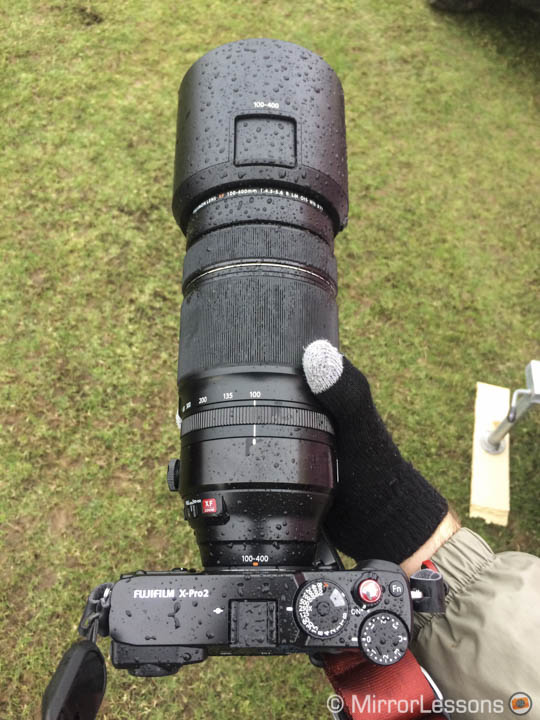
What you see in the image above is just the beginning. It rained for more than three hours and the X-Pro2 and 100-400mm were soaked through by the end of the race, but they kept on working without any problem. So yes, the weather sealing is good!

One of my last shots before the race being cancelled.
Note about the X-Pro2 weather-sealing
Although this article is about the XF 100-400mm, I thought it was worth sharing the following feedback about the X-Pro2.
The X-Pro2 survived the rain very well. However, once I returned home, I noticed that two tiny water droplets had made their way inside the SD card slot. They were very tiny and close to the entrance so the memory cards remained completely dry.
I suspect this happened because during the hail storm I had to make my way back quickly (the races were cancelled in the end). I walked for 5 minutes in very heavy rain, and I was carrying the gear with my strap over my shoulder on the right side. The camera and lens were hanging in a vertical position, so the rear of the X-Pro2 was facing up. I guess the SD card door was more exposed to the heavy rain. This could be a weak spot on the camera so in extreme circumstances it is better to protect it somehow (put it under a jacket for example).
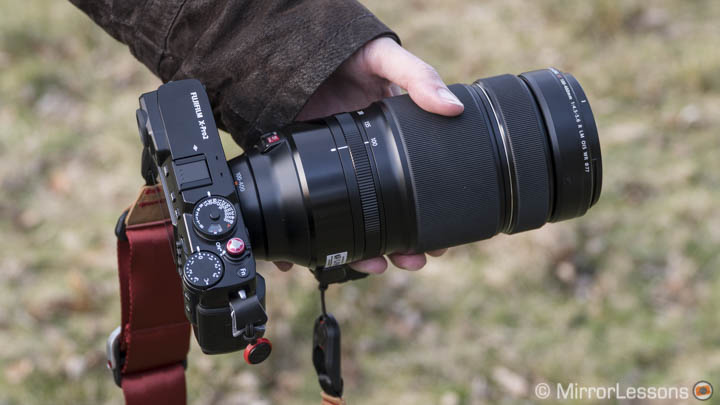
As I mentioned at the beginning, the lens is heavy and weighs more than 1.3kg. It is the largest lens Fujifilm has ever designed for the X system. I found it more tiring to hold after an entire day of shooting in comparison to other Fujifilm or m4/3 telephoto lenses. With both the X-T1 and X-Pro2, the combo can be a little front heavy.
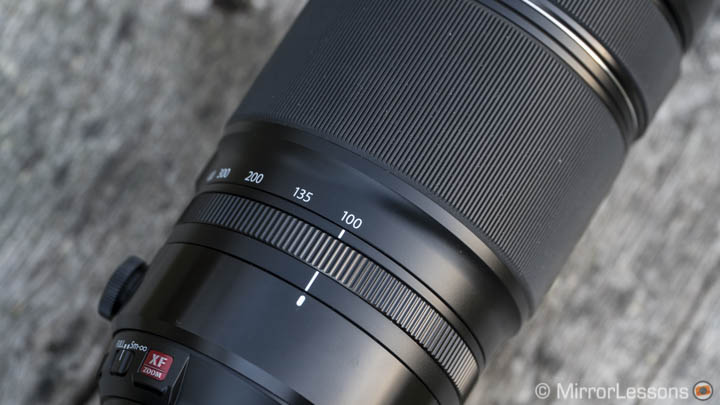
The various rings are precise and smooth to use. The aperture ring clicks in 1/3 steps. The zoom and focus rings are covered by ribbed rubber to enhance the tactile experience. I found the focus ring precise to use despite being a “focus by wire” type. The zoom mechanism is not internal so the lens extends when zooming in.
The zoom ring is a little bit stiff near the end (longest focal length). It can be locked at 100mm to prevent the lens from extending when carried in a vertical orientation. If you don’t lock it, it can extend quite easily.
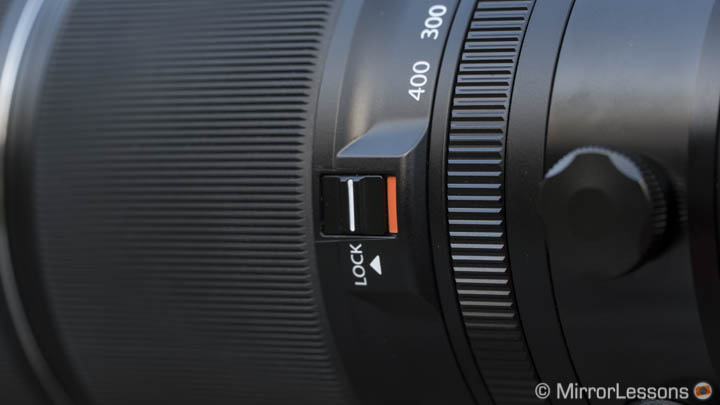
On the side of the lens you can find three switches that are common on this type of lens. They allow you to limit the focus distance to 5m-∞, set the aperture to Automatic or Manual and turn the optical stabilisation On or Off .
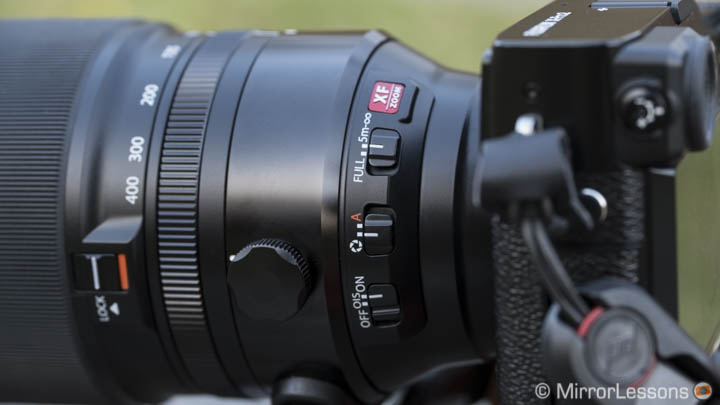
The lens hood is made of robust plastic. I like its lock mechanism. There is an unlock button that you need to press to remove it so you are sure that the hood doesn’t move in any way while using the lens. Like the XF 50-140mm, it has a small sliding window, which is useful to access a polarising filter.
Finally we have the tripod collar that can be rotated 360° or removed with the two dedicated knobs.
Optical quality
The Fujinon XF 100-400mm gives you the same angle of view of a 150-600mm if we refer to the 35mm format. It has a non-constant aperture that goes from f/4.5 at 100mm to f/5.6 at 400mm.
I found the overall optical performance to be at the same level of other professional Fuji lenses as well as other recent telephoto lenses I’ve tested. Sharpness is excellent at the fastest aperture and throughout the entire zoom range.


Let’s have a look at some simple tests to see exactly what we are talking about beginning with what interests us most. Above and below you can see that sharpness is excellent at f/5.6 already and 400mm. The peak performance is found at f/8. From f/11, diffraction starts to appear and that happens at every focal length.

Click on the image to open the full res version.

Click on the image to open the full res version.
Sharpness was similar at the longer focus distances too, which is where you’d be more likely to use this type of lens. Again f/8 gives you the best performance. f/11 and f/16 remain usable for panning shots if you are working on a sunny day.

I took two comparison shots with approximately the same magnification at 300mm and 400mm to see if the lens would suffer more at the longest focal length. Happily, this is not the case. I found sharpness to be very similar in both cases. The optical performance stays at the same level at 100mm and 200mm.
Note: you can see a complete comparison set here.
Long story short: you can use the lens at any focal length without worrying about a decrease in sharpness with the best performance being between f/4.5 and f/8. Diffraction is the only limit.
The versatile zoom range and the non-constant aperture usually don’t help to make the bokeh more attractive.
However I have to say that the XF 100-400mm managed to surprise me. I didn’t find too many hard edges or double images even in busy composition. Overall you get a smooth out of focus background and its capability to isolate the subject is good even at longer distances. With shorter focus distances you can encounter a slightly swirly effect which is not unpleasant.




The Fuji 100-400mm can focus as close as 1.75m through the entire zoom range. At 400mm it gives you a magnification of 0.19x (APS-C standard).
The example below shows a friendly robin at 1.75m. He was probably hoping to get some food but he got his picture taken instead!
I had to switch to manual focus because the camera couldn’t handle the situation. As you can see, sharpness remains really good at short distances too.

Click on the image to open the full res version.
You can notice some very slight vignetting at the longest focal lengths and fastest aperture but it is nothing worth worrying about. I never had to deal with chromatic aberration. As for flare, if you really take the time, you can eventually find some but in most situations you won’t have to deal with it.

Autofocus
Single AF and short distances
While I tested the lens on the X-Pro2 mainly to get an idea of how Fuji’s new AF system performs, I also took shots with the X-T1 to give you a more complete understanding of its performance.
As far as the lens is concerned, it behaved very well on both bodies. The AF motor is fast and almost completely silent.
In single AF, the only real problem I encountered was at the shorter focus distances where both cameras struggled. The best thing to do in this case is to switch to manual focus if the camera keeps mis-focusing or moving the lens elements back and forth.

Here I had to switch to manual focus because the AF couldn’t handle the short distance.
You can also encounter problems at times with busier compositions like a small bird on a tree (some back-light won’t help either). Setting the AF to a single and smaller point helps but doesn’t always solve the problem and in some cases the camera can mis-focus completely.

An example of a composition where the AF can struggle to lock onto the bird.
The best thing to do in this case is to pre-focus near the subject first so that the camera doesn’t have to change the focus distance too much when locking onto the subject.
To be fair, I’ve encounter this behaviour with other cameras I’ve tested as well with long focal lengths so I don’t consider it a major problem.
Continuous AF with the X-Pro2
The X-Pro2 and XF 100-400mm managed to surprise me on multiple occasions in C-AF. I used the gear for an evening soccer game, a motorbike race and birds in flight. Not only did it work well but it is currently one of the best mirrorless AF systems I’ve had the chance to test in these scenarios.



I always thought that Fujifilm was on the right track with the X-T1 and the X-T10/Firmware 4 but still needed to upgrade the hardware to really make a difference. This is now a reality with the X-Pro2.
I can only guess it will happen again with the X-T2 (or X-T1s or X-T1 mark II or whatever name they decide to give it!).
My favourite settings with the X-Pro2 for sports and BIF
- – C-AF and continuous shooting on High (8fps)
- – Zone AF with the largest area (BIF), largest or middle areas for motorbikes and football
- – Power management to High Performance (which gives you the 85fps refresh rate in the EVF). Be aware that the battery life will drop quickly. I had three with me.
- – Focus priority for BIF and motorbikes, release priority for football.
- – Pre-AF: Off
- – Auto ISO 1 (max. 800) for good light conditions, Auto ISO 2 (max. 3200) for cloudy conditions, Auto ISO 3 (max. 12800) for low light conditions.
I only used the Zone AF area as I find it so effective and reliable. It also allows you to have more room to compose while following a fast subject even if you are not able to keep it exactly at the centre of your frame.
For both the football game and the motorbike race, I got a keeper rate of approximately 80%.

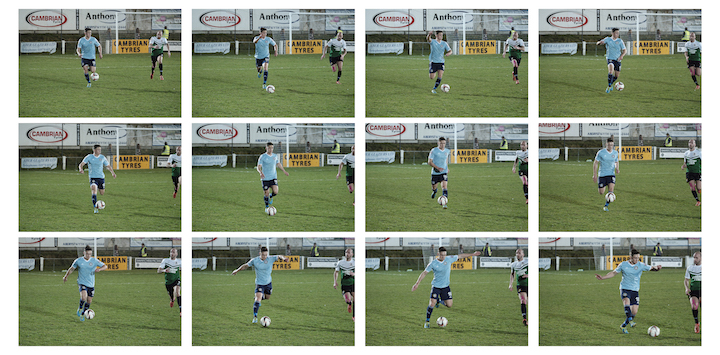
I was particularly impressed with the soccer game. Being an evening event and the lens not being so fast, I had to use Auto ISO with the maximum set to 12800, which is the value the camera picked most of the time. Not only did I get very usable images but the AF really did a fine job and most importantly, it always had consistant behaviour even when my tracking movements were less precise.
I did end-up with some slightly soft results and at times the camera confused the subject with the background like in the example below but I don’t have lots of negative examples.

Another example where the camera failed to lock the subject.
If you select release over focus priority, the AF performance remains very similar. However at times the camera can mis-focus completely and take the shot anyway if the change in focus distance is too great. To be fair, it only happened a couple of times.
The keeper rate was lower for birds in flight (around 60%) I consider that genre more challenging for the AF system. Plus, the photographer’s abilities are also relevant and I’m still an amateur when it comes to BIF.

Click to open the full res version
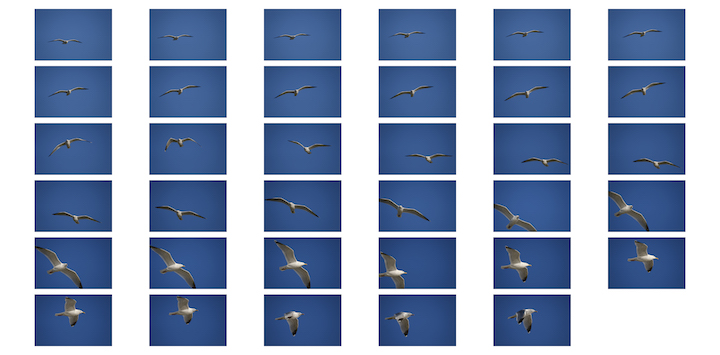
Continuous AF with the X-T1
With the X-T1 the overall performance is slower in comparison to the X-Pro2 and I found the difference more relevant for birds in flight in particular. Note that when shooting at 8fps, both cameras use the phase detection area only but the one on the X-T1 is smaller so you end up working with a smaller AF area. That requires you to be more precise at following a fast bird which is anything but easy.

Click on the image to open the full res version.

Click on the image to open the full res version.
My favourite settings with the X-T1 for BIF
- – C-AF and continuous shooting to High (8fps)
- – Zone AF with the largest area (5×3)
- – Power management set to High Performance
- – Focus priority
- – Pre-AF: Off
- – Auto ISO (max. 800 for sunny, max. 3200 for cloudy conditions)
Although not related to the autofocus, I was also surprised to see the difference in EVF performance between the X-T1 and the X-Pro2.
Despite the X-Pro2 viewfinder being smaller, it has a faster refresh rate of 85fps (when you set the Power Management to High performance) and I also found the lag time between the shots to be lower when shooting at 8fps.
Speaking of viewfinders, you might be interested to read my experience using the optical viewfinder of the X-Pro2 with the 100-400mm lens for birds in flight. I know it sounds crazy but it actually works!
Optical stabilisation
Fujifilm claims 5 stops of compensation with the built-in optical stabilisation and I must say the lens OIS works really well. At 400mm, I managed to get a sharp shot at 1/8s and 1/5s at 100mm with both the X-T1 and X-Pro2.

Click on the image to open the full res version.

Click on the image to open the full res version.
As usual in the real world, remember that a higher shutter speed will always ensure more sharpness when shooting at 300mm or 400mm. Plus no matter how still you are or how good the OIS is, your subject might not want to pose for you for too long. I got some slightly blurry shots even at 1/250s or above.

Click on the image to open the full res version.

Click on the image to open the full res version.
The OIS is also effective for video. You can watch an example in our video review at minute 9.22.
The Fuji 100-400mm + XF 1.4X Teleconverter
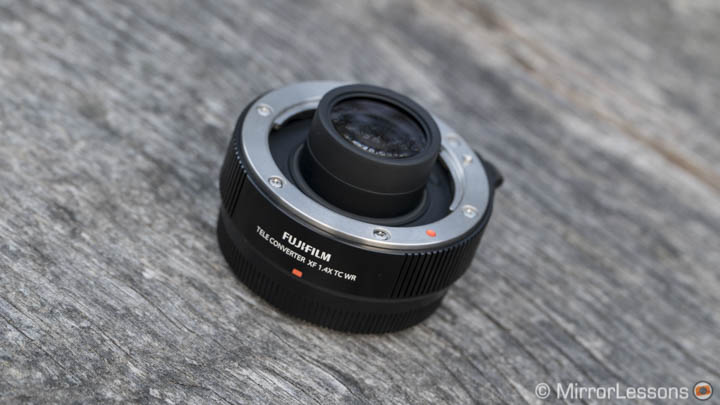
With the 100-400mm lens I also rented the 1.4 teleconverter. It is the second lens to be compatible along with the 50-140mm f/2.8. The focal length becomes 140-560mm which is equivalent to a 210-840mm in 35mm format. The fastest aperture becomes f/6.7 at 100mm and f/8 at 400mm.
Concerning the optical performance, there is a slight loss in sharpness. It is not huge but it is worth mentioning. The best performance is once again at f/8 and that aperture becomes the best way to get the best sharpness possible.

Click on the image to open the full res version.

Click on the image to open the full res version.

Once again I tested it on both the X-Pro2 and X-T1. With the teleconverter the autofocus performance was slower on both cameras. The cameras can take more time to lock onto the subject and can be less accurate especially with birds in flight.

The best results I got with the 100-400mm and TC 1.4 was at the motorbike race. The converter is also weather-sealed and survived the same horrid conditions without any problem.


Conclusion
The XF 100-400mm is an excellent lens as far as optical quality is concerned. I wouldn’t go as far as saying that I was impressed but I felt it was at the same level as other premium telephoto zooms and on par with the quality Fujifilm has given us already with other zoom lenses such as the XF 16-55mm and XF 50-140mm. The optical stabilisation does an excellent job and the AF motor is fast. Coupled with the X-Pro2, I got some of the best results ever in Continuous AF.

The only real argument worth mentioning (but not necessarily in a negative way) is the size and weight.
It definitely felt closer to a DSLR lens. We could compare specs and notice that a Canon 100-400mm is still a little heavier but sometimes personal feelings are more important than numbers on a specs sheet.
In a way I am not surprised because this is where mirrorless systems are going lately. The brands are releasing high quality lenses that require more volume for various reasons. The reasoning here can be seen from two sides.

If you are already a Fuji customer and were waiting for a high quality lens with a long reach for wildlife or sports photography, this is the only real choice you have so the discussion ends here.
However if you are looking into an alternative to a DSLR for wildlife photography, I think the difference is less relevant. The price is on par with other lenses of this type (nearly $1900) so you won’t gain anything there, and there is also the fact that for now the best match is the X-Pro2 which is quite expensive. Yes, the Fuji combo is lighter but perhaps not as light as you might hope (and the Fuji lens is actually slightly longer than the Canon equivalent). Yes, the AF on the X-Pro2 has improved considerably but I bet it isn’t superior to a 7D mark II. Plus there is another aspect to consider and that is the viewfinder position. I admit that I find the EVF at the centre more comfortable to use. I guess we can continue this topic once the X-T1 successor is out!

 What I like about the Fujifilm 100-400mm f/4.5-5.6:
What I like about the Fujifilm 100-400mm f/4.5-5.6:
- Top notch build quality and weather sealing
- Excellent sharpness throughout the entire zoom range and fastest apertures
- Good bokeh rendering
- Good optical stabilization
- Fast AF motor with both X-T1 and X-Pro2
 What I don’t like about the Fujifilm 100-400mm f/4.5-5.6:
What I don’t like about the Fujifilm 100-400mm f/4.5-5.6:
- Large and heavy on most Fuji camera bodies
- The zoom ring is a little bit stiff at the longest focal length (at least on the sample I rented)
- Diffraction starts from f/11 (but remains acceptable up to f/16)
 What can be considered about the Fujifilm 100-400mm f/4.5-5.6:
What can be considered about the Fujifilm 100-400mm f/4.5-5.6:
- It might not be the best solution for someone looking at a lighter or less expensive alternative for wildlife photography.
The Fuji 100-400mm vs. similar offerings from other mirrorless systems
Because I am testing various combos for wildlife and sports you might wonder what I think about this Fuji set versus the Panasonic or Olympus options (I’m working on Sony next!).
As I wrote earlier, the XF 100-400mm’s sharpness didn’t impressed me in comparison to the Olympus 300mm Pro or the Pana/Leica 100-400mm. However I did find the overall set-up with the X-Pro2 slightly better in terms of overall image quality (larger sensor, more resolution) and the possibility to separate the subject from the background. It’s not a huge difference but worth mentioning.

I definitely got some of my best shots of birds in flight with the X-Pro2 but in total honesty, it is also because I’m getting used to it more now and I’ve improved thanks to my experience testing these lenses. The next on the list is the Sony a6300. Stay tuned!
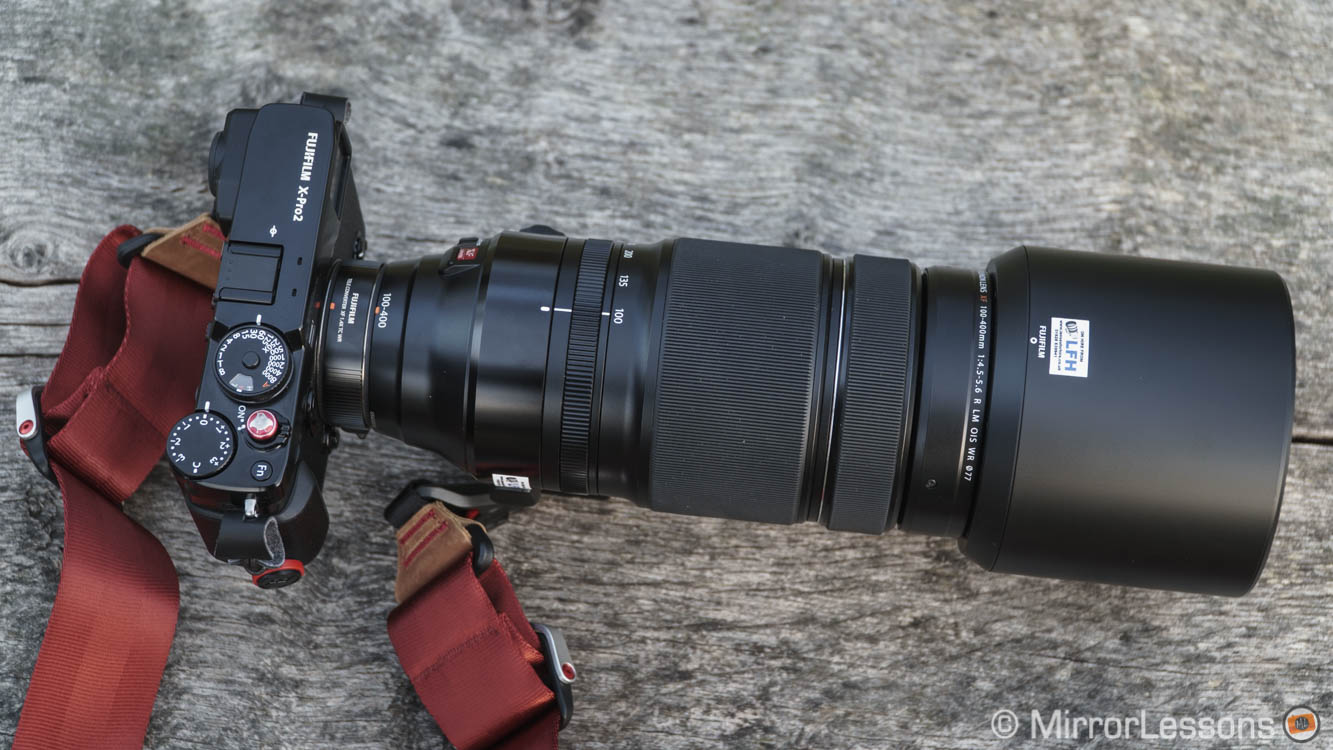



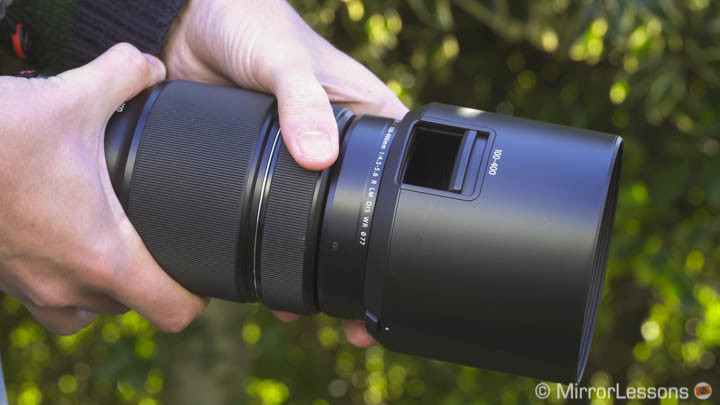








I would say the X-Pro2+100-400mm combo is faster and gives more constant results.
What about compared to Sigma lens with Metabones adapter that you tested previously?
I haven’t tested yet the Sigma adapter so for now I would say X-Pro2 and 100-400mm.
Mathieu, thank you for the excellent review. I currently own X Pro2 as well as A7rII and I would like to know in your opinion which combo would be better A7rII + Sigma adapter + Sigma 150-600 C or X Pro2 + Fuji 100-400 ?
Brilliant, looking forward to it.
We are currently testing the a6300. Yesterday I took some BIF pictures with the LA-EA3 and 70-400mm A-mount lens but the results weren’t as good as with the X-Pro2. However I need to do the test again with a native E-mount lens before making any conclusion. For now the only interesting comparison I have is the evening football game because Heather used the a6300 while I was using the X-Pro2 and we got very similar results when it comes to AF speed but the type of lenses we used were different. I’m planning to make more side by side tests in the following days as I am also preparing an X-Pro2 vs a6300 article.
Mathieu, DPR are comparing the 7d with the a6300 on their website, I linked a few comments back to your site for comparison with the xpro2. Guy at DPR, Richard B. does not rate the xpro2 af as fast as Sony? Be interested in your comment on this, especially as you were able to get some really great action shots. Below or on the post where you use the ovf you thought xpro2 was at or near the top especially as the lens options, uhs-ii support and weather sealing make the xpro2 more equipped for this sort of shooting too, even more so in Wales! Any further comments now you’ve had the a6300 for a while?
Yes they are tagged, they are all protected species in the area.
The a6300 is excellent so far, perhaps even better than the X-Pro2. But I’m curious to see what the E-M1 successor will have as well.
Thanks for the tip Andrew. Sometimes I hold the lens by its foot but I don’t do that all the time to be honest especially if I need to shoot for a long period of time.
I liked your video on the Fujifilm 100-400. I use this on my X-T1, while waiting for the X-T2, primarily for shooting wildlife, including birds, set at 400, and sometimes also add the teleconverter. This makes it difficult to hold the lens with stability.
In your video I noticed you were holding the lens by its foot, which makes it somewhat front heavy. For short periods I hold it by the lens hood, with the hole for the polarizer underneath the lens, rather than at the top, as in your video. I make a V with my index finger and middle finger, and hold the front of the lens hood in the V. Then I put my thumb nail against the far end of the hole in the hood, effectively creating a tripod with two fingers and the thumb. Finally, I press my elbows against the sides of my chest for more stability. This makes it necessary to look through the viewfinder rather than the screen.
really nice shots mathieu are the red kites tagged noticed the coloured tags on there wings . if i ever move from m43 this review has made my mind up those look really nice images as you noted more isolation than m43 ,well until you review the a6300 that is , which i would like also to see ,i feel these two cameras offer better c-af systems than either my gh4,omd em-1 or gx 8 .
Thanks Jerry. There is definitely an improvement with the X-Pro2 and I would be surprised if Fuji doesn’t update the X-T1 with the same capabilities (if not even better).
Superb review, Mathieu, I’ve been looking forward to seeing it after your excellent previous article. Your comments on overall performance for BIF was particularly useful and jives with my own experience using the X-T1 in combination with the 100-400 (and often the TC as well). I’m using similar settings to what you recommended for BIF and motion tracking. I’m particularly encouraged by your observations on the improvement in performance you’re seeing with the X-Pro2. While much of the struggle I’ve been experiencing with BIF is due to my own inexperience, your review suggests that some (maybe many) of the issues I’ve encountered with accurate tracking may improve significantly with the X-T2 (assuming similar or better AF improvements than the X-Pro2). Again, many thanks and I’m anxiously awaiting what Fuji has to offer with the X-Tn series.
Yes I know that the sunshine came back! But I think the races were cancelled anyway.
What I mean is that I didn’t find the Fuji lens to be sharper than the Pana-Leica lens. Both lenses seem to be at the same level.
Hi Mathieu…great work as always,,bet you miss the sunshine from back home…I’m a Welshman…anyway,,in your review you said this…
“As I wrote earlier, the XF 100-400mm‘s sharpness didn’t impressed me in comparison to the Olympus 300mm Pro or the Pana/Leica 100-400mm.”
Your images look superb but is it a fact that the xf100-400 is not as sharp as the leica??
Dave…
The AFC and tracking capabilities are also related to the camera. The Fuji 100-400mm+X-Pro2 combo is the best I’ve tested so far when it comes to continuous AF and tracking (more constant results, better keeper rate). With the X-T1 the performance was slower. The E-M1 +40-150 gave me great results when I tested the lens but the X-Pro2 is superior with the AF also because the camera is more recent. When the E-M1 successor comes out that could change again.
As for sharpness, I don’t see a relevant advantage of one over the other but I tested the Oly lens a while ago so I can’t give you more precise feedback. The E-M1+40-150-TC gear will give you a faster aperture overall and that can help. The Fuji 100-400mm gives you more telephoto reach which can be useful for birds in flight. But with m4/3 you also have other lens options if you need more reach.
Here in Wales there are several red kites feeding stations and some of them are free. One of the best is at the Girgin farm but I often go here: https://naturalresources.wales/out-and-about/places-to-go/mid-wales/bwlch-nant-yr-arian-forest-visitor-centre/?lang=en because it’s closer for me.
I’m not sure which gear I would pickup, I admit that the Pana 100-400 with the E-M1 is the best for size and weight and the lens is excellent. The X-Pro2 is better concerning AF but that could change once the E-M1 successor is out. I’ll have a better idea at the end of the year 🙂
Perhaps with an additional grip or the battery grip on the X-T1 things improve a little.
Mathieu,
many thanks for this great (as always) review! As I am an Olympus shooter with EM1 and 2.8/40-150, I would be interested how you would compare the Fuji 100-400 to the Olympus 2.8/40-150 on the EM1 (also with TC) in the disciplines of sharpness, AF speed and accuracy, AFC and AF tracking.
Thanks in advance
Peter
Another excellent review Mat. Looking forward to your a6300 impressions. The better half has ordered the a6300 and a Sony PZ 18-200 for travel video. Now all we need is a native e-mount in 400mm 🙂
Now that you’ve used the XPro-2 and 100-400, the OMD M1 with Oly 300 and the Panasonic GX8 with their 100-400, if all three were on the table and your were headed out to shoot Kites which would you grab??????
Speaking of the Kites you frequently shoot, where are they? Open to the public? What season is best?
Thanks as always.
I also tried this lens on the XT1, I agree it’s heavy , not as much as say Sigma 150-600 sport but DSLRs have better ergonomics for that,ie better balance.